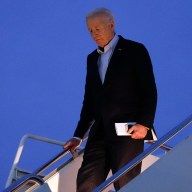Have you stopped to see the Museum station yet? I am charitably disposed to the $2-million philanthropic gift that helped redesign the station platform. The welcome donation in turn leveraged more millions from the province and TTC.
Next, we need to look at the rest of the system and at a TTC maintenance and cleaning budget that can’t seem to keep up with heavy ridership and aging structures.
A gradual station-by-station rebuilding effort will help, but something is still wrong with our underlying ability to keep existing and new spaces satisfactorily clean and repaired.
Look at the recently expanded Broadview station. Open less than a year, the access corridor between train and streetcar platforms is already in sorry shape. New tiles and other surfaces are smudged by graffiti paint while water runs down a staircase from a ceiling leak. It’s not a good sign for fresh construction to appear haggard so soon.
I don’t see how to address the wider problem unless Torontonians take a more proactive role and insist that sufficient public funds are available — and that it is spent well.
The idea that citizens can enhance their feeling of ownership in the transit network is not far-fetched. I saw this capacity in action last weekend at the first session of Metronauts — the quirky “unconference” promoted by Metrolinx as a way to develop its upcoming Regional Transportation Plan.
At Metronauts anyone can suggest a topic. Each person who joins a particular discussion gets a real chance to contribute — it’s expected in fact. Comments are recorded for later consideration and may influence the final plan.
Several more sessions are planned across the region and I hope to see what 905 commuters have to say — especially when they realize that eager Metrolinx planners are genuinely interested in a variety of opinions.
Too often transit professionals seem ill at ease with public input from “non-experts” and sometimes the problem is inadequate resources. Staff simply may not have enough time to deal with a high volume of suggestions and questions.
Citizens will continue to offer help on their own terms, so our institutions need to evolve better ways to gratefully accept.
Recently, I’ve been observing as first-year engineering students devise solutions for common transit problems. Next Monday, a University of Toronto engineering science class will address topics such as improving safety for passengers exiting streetcars, real-time schedule information and better access at unmanned subway station entrances.
TTC staff also may have pondered these and other challenges, so I hope some will be able to find time on Monday to view the presentations and combine forces with this youthful creativity. See more at engsci.
utoronto.ca by clicking on “Praxis II.”
















